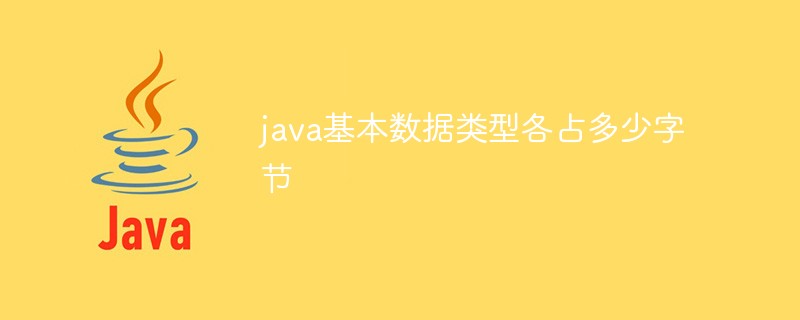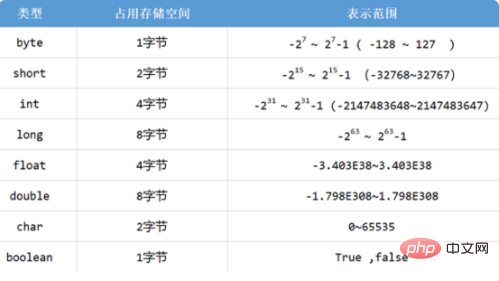
Java's basic data types each occupy 1 byte: 1. Integer byte occupies 1 byte, short occupies 2 bytes; 2. Float occupies 4 bytes, and double occupies 8 bytes. Bytes; 3. Char type occupies 2 bytes.

Related learning recommendations:java basic tutorial
There are a total of 8 types in Java Basic data types, including 4 integer types, 2 floating point types, 1 character type used to represent Unicode-encoded character units, and 1 boolean type used to represent true values.
One byte is equal to 8 bits, and Java is platform-independent.
(1) Integer type:
Among them, byte, short, int, and long all represent integers, but their value ranges are different
The value range of byte is -128~127, occupying 1 byte (-2 to the 7th power to 2 to the 7th power -1)
The value range of short is -32768~32767, occupying 2 bytes (-2 to the 15th power of 2 -1)
The value of int The value range is (-2147483648~2147483647), occupying 4 bytes (-2 to the 31st power of 2 -1)
The value range of long is ( -9223372036854774808~9223372036854774807), occupying 8 bytes (-2 to the 63rd power of 2 -1).
You can see that the value range of byte and short is relatively small, while the value range of long is too large and takes up a lot of space. Basically int can meet our daily calculations. , and int is also the most commonly used integer type.
Under normal circumstances, if an integer number such as 35 appears in JAVA, then this number is of int type. If we want it to be of byte type, we can add a capital B after the data: 35B , indicating that it is of byte type.
Similarly, 35S represents short type, and 35L represents long type. If it represents int, we can add nothing, but if we want to represent long type, we must add "L" after the data.
(2) Floating point type:
float and double are data types representing floating point types. The difference between them is that they The accuracy of second power) occupies 4 bytes
double 1.797693e 308~ 4.9000000e-324 occupies 8 bytes
double type is better than float type has a larger storage range and higher precision, so usually floating-point data is of double type without declaration. If you want to indicate that a data is of float type, you can add "F" after the data.
This type has only two values, true and false (true and not true)
boolean t = true;
boolean f = false;
The data type used to store characters, occupies 2 bytes, uses unicode encoding, and its first 128 bytes of encoding are compatible with ASCIIThe storage range of characters In \u0000~\uFFFF, pay attention to adding ' ' when defining character data. For example, '1' means the character '1' instead of the value 1,
char c = ' 1 ';
Let’s try to output c. System.out.println(c); The result is 1, but if we output it like this System.out.println(c 0);
The result becomes 49.
Extended information
Conversion between basic typesAssign a value of one type to another One type is very common. In Java, it is clear that the boolean type cannot be converted to the other 7 types of data.
But for the other 7 data types, they can be converted between them, but there may be a loss of precision or some other changes.
Conversion is divided into automatic conversion and forced conversion:
Automatic conversion (implicit): no operation required.
Forced conversion (explicit): You need to use the conversion operator (type).
Arrange the six data types in the following order:
double > float > long > int > short > byte
php training
column!The above is the detailed content of How many bytes do each of Java's basic data types occupy?. For more information, please follow other related articles on the PHP Chinese website!